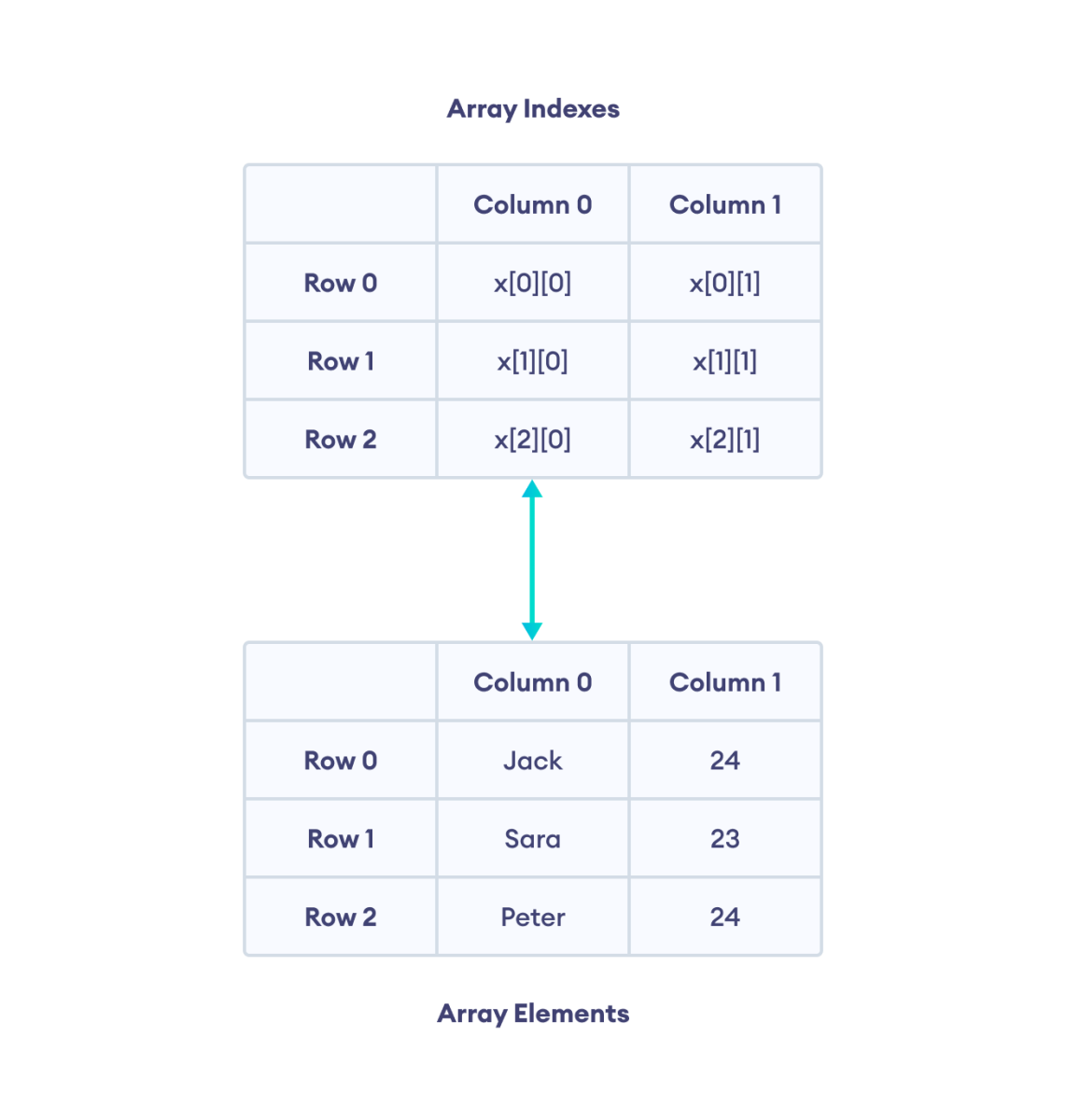在 JavaScript 中,多维数组在其内部包含另一个数组。
这是一个多维数组的简单示例。阅读本教程的其余部分以了解更多信息。
示例
// multidimensional array
// contains 3 separate arrays as elements
const data = [[1, 2, 3], [1, 3, 4], [4, 5, 6]];
console.log(data);
// Output : [ [ 1, 2, 3 ], [ 1, 3, 4 ], [ 4, 5, 6 ] ]在这里,我们创建了一个名为 data 的多维数组,其元素为数组:[ 1, 2, 3 ]、[ 1, 3, 4 ]、[ 4, 5, 6 ]。
使用现有数组作为元素
我们也可以通过将现有数组嵌套在其中来创建多维数组。例如,
// declare three arrays
let student1 = ['Jack', 24];
let student2 = ['Sara', 23];
let student3 = ['Peter', 24];
// create multidimensional array
// using student1, student2, and student3
let studentsData = [student1, student2, student3];
// print the multidimensional array
console.log(studentsData);
// Output: [ [ 'Jack', 24 ], [ 'Sara', 23 ], [ 'Peter', 24 ] ]在这里,我们首先创建了三个名为 student1、student2 和 student3 的数组。
然后,我们将这三个数组嵌套在 studentsData 数组中,以创建我们的多维数组
let studentsData = [student1, student2, student3];访问数组元素
您可以使用数组索引来访问多维数组的元素。例如,
let x = [
['Jack', 24],
['Sara', 23],
['Peter', 24]
];
// access the first item
console.log(x[0]); // [ 'Jack', 24 ]
// access the first item of the first inner array
console.log(x[0][0]); // Jack
// access the second item of the third inner array
console.log(x[2][1]); // 24输出
[ 'Jack', 24 ] Jack 24
您可以将多维数组(在本例中为 x)视为一个具有3行和2列的表。

向多维数组添加元素
您可以使用索引表示法或 push() 方法向多维数组添加元素。
1. 使用索引表示法
let studentsData = [["Jack", 24], ["Sara", 23]];
// add "hello" as the 3rd element
// of the 2nd inner array
studentsData[1][2] = "hello";
console.log(studentsData);
// Output: [ [ 'Jack', 24 ], [ 'Sara', 23, 'hello' ] ]2. 使用 push() 方法
push() 方法将元素插入数组的末尾。例如,
let studentsData = [["Jack", 24], ["Sara", 23]];
// add element to the end of the outer array
studentsData.push(["Peter", 24]);
console.log(studentsData);
// add "hello" as the final element
// of the 2nd inner array
studentsData[1].push("hello");
console.log(studentsData);输出
[ [ 'Jack', 24 ], [ 'Sara', 23 ], [ 'Peter', 24 ] ] [ [ 'Jack', 24 ], [ 'Sara', 23, 'hello' ], [ 'Peter', 24 ] ]
您还可以使用 splice() 方法在指定索引处添加元素。例如,
let studentsData = [["Jack", 24], ["Sara", 23]];
// add element at 1 index
studentsData.splice(1, 0, ["Peter", 24]);
console.log(studentsData);
// Output: [ [ 'Jack', 24 ], [ 'Peter', 24 ], [ 'Sara', 23 ] ] 从多维数组中删除元素
您可以使用 splice() 方法从多维数组的任何位置删除元素。例如,
let studentsData = [['Jack', 24], ['Sara', 23],];
// remove one element
// starting from index 0
studentsData.splice(0,1);
console.log(studentsData);
// Output: [ [ 'Sara', 23 ] ]在上面的程序中,studentsData.splice(0,1) 删除了多维数组的第一个元素。这里,
- 0 - 要修改数组的起始索引。
- 1 - 要删除的元素数量。
如果要删除两个数组,可以使用代码 studentsData.splice(0,2)。
如果要从多维数组中删除最后一个元素,可以使用 pop() 方法。
删除外层数组中的元素
let studentsData = [["Jack", 24], ["Sara", 23]];
// remove the array element from outer array
studentsData.pop();
console.log(studentsData);
// Output: [ [ 'Jack', 24 ] ]删除内层数组中的元素
// remove the element from the inner array
let studentsData = [['Jack', 24], ['Sara', 23]];
studentsData[1].pop();
console.log(studentsData);
// Output: [ [ 'Jack', 24 ], [ 'Sara' ] ]遍历多维数组
在 JavaScript 中,您可以使用嵌套循环来遍历多维数组:一个循环用于外层数组,另一个循环在其中用于内层数组。例如,
let studentsData = [["Jack", 24], ["Sara", 23]];
// loop over outer array
for(let i = 0; i < studentsData.length; i++) {
// loop over inner array elements
for(let j = 0; j < studentsData[i].length; j++) {
console.log(studentsData[i][j]);
}
}输出
Jack 24 Sara 23
您还可以使用 数组的 forEach() 方法 来遍历多维数组。例如,
let studentsData = [["Jack", 24], ["Sara", 23]];
// iterate over studentsData
studentsData.forEach((student) => {
student.forEach((data) => {
console.log(data);
});
});输出
Jack 24 Sara 23
第一个 forEach() 方法用于遍历外层数组的元素,第二个 forEach() 用于遍历内层数组的元素。
您可以使用 for...of 循环来遍历多维数组。例如,
let studentsData = [["Jack", 24], ["Sara", 23]];
for (let i of studentsData) {
for (let j of i) {
console.log(j);
}
}输出
Jack 24 Sara 23